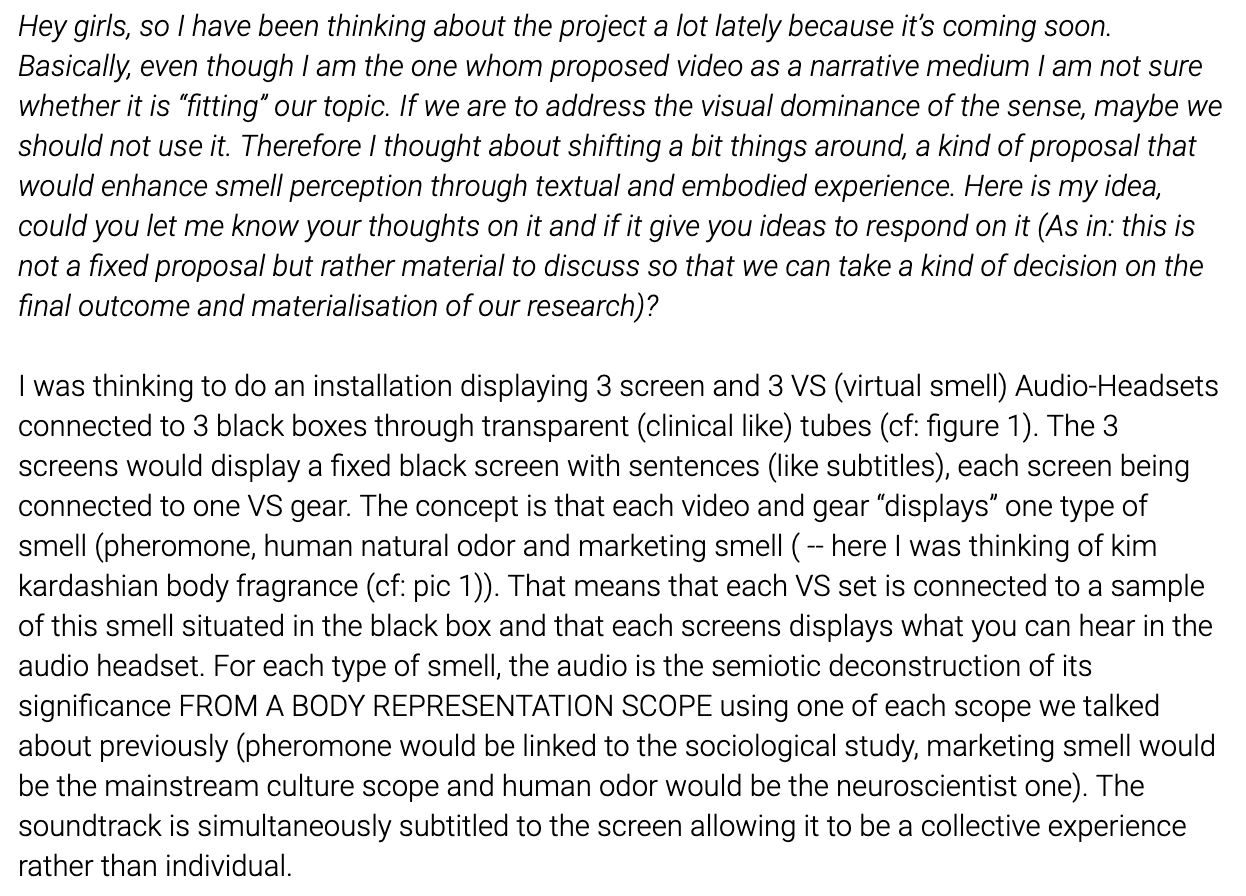Olfaction - Group Research Project WIP Discussion Documentation
# Term1_8
In this week our Ordor research project made quite a lot progress. Juliette proposed an idea of the artifact installation, which combines an ASMR style audio record of text about three semiotic materials of body smell (1.Neurosciences, 2. Sociology, 3. Mainstream culture) and a device to store the related smells for the audience to smell (1. Natural body ordor, 2. Synthetize smell, 3. Pheromones).
I love this idea. However I felt like the relationship between the smells in the device and the responding semiotic text material were not very clear. So I drawed some supports from the theories of Feminist Techonoscience and the Embodied ordors, analized our materials and made a clearer framework. Here're the details:
*marketing smell (ethnic/class semiotics)+ human odor
1. HUMAN - MACHINE
(related to A Cyborg Manifesto - Ambiguity in distinctions among animal - human - machine)
The (mainstream) society always tend to neutralise the human body smell, i.e. deny the human body’s secretion/ the olfactory signs that are produced by organic process (‘Embodied Odors: smells, bodies and contemporary art’ page1 last paragraph) For example products like deodorant, perfume, gum.
So there are two kinds of body odors: the organic human odor (“odor-prints”, individual odor portraits), and the fabricated marketing smell(“fabricated smell identity” - which is not produced by our bodies, which we put on our bodies, to attach ourselves ‘ideal olfactory identity’.) (‘Embodied Odors: smells, bodies and contemporary art’ page2. 2nd paragraph)
The phenomenon of human to neutralise/‘unload’ their organic body smell, and to ‘install’ other (social ethnic/class semiotics carrying) synthetic inorganic smell on their body - could be regarded as that in this way, human treat themselves like the machine.
2. ETHNIC/CLASS SEMIOTIC REPRESENTATION
Although “odor-prints” are individual odor portraits, olfactory identity is also understood on a broader social level. - ‘Embodied Odors: smells, bodies and contemporary’ Page2. 2nd paragraph
On a narrow/ literal level, our nature body odor is our identities ’true/real’ representation. However on a broader social level, the fabricated odor we ‘install’ on our bodies is also regarded as part of our identities representation. So there’s the ambiguity that worth to question the audience: what is your true/ real/ accurate representation (in smell)? Is there a true/ real/ accurate representation of yours (in smell)?
1. GENDER (and sex orientation maybe?) DIFFERENCE (in terms of body odor)
- society tend to believe ‘female is easier to fall in love/ get attracted than male’
In the neurosciences discourse, they try to prove it through the pheromone sensitivity & pleasantness in different genders (Female is more sensitive and satisfied with the pheromone - discussed in the journal ’Sex differences in human olfaction: Between evidence and enigma’ mainly form page262). But obviously many of us wouldn’t agree on it. (As I think it’s kinda presenting that the male body has higher domination than the female body? - not very clear about this idea yet, could be discussed further)
So by presenting the pheromone smell box, we could question the body representation in different gender/sexuality. (For example like questioning ‘is there the higher level/ more major gender/sexuality?’ - As in the actual smell experience, female/male audience might find they can/cannot smell it, or find it pleasant/unpleasant.) (I meant not actually typing the question in the text, but like the text contents make people think about these kind of questions.)
2. HUMAN - ANIMAL
(related to A Cyborg Manifesto - Ambiguity in distinctions among animal - human - machine)
The mainstream society have negative attitude to human body secretions like axillary secretions and urine. But especially in sexual behaviour, some people fascinate them.
(’Sex differences in human olfaction: Between evidence and enigma’ mainly form page262. 2nd paragraph beginning) This phenomenon could be seem as human strip the animality to ‘be more human’, but at the same time there is the animality/instinct in the human nature.


© bingcomputing 2019
*marketing smell (ethnic/class semiotics)+ human odor
*pheromone + human odor
Embodied Odors: smells, bodies and contemporary art by Laura Estrada Prada.pdf [WWW Document], n.d. . Google Docs. URL https://drive.google.com/file/d/1DSX7sNNukIisRmdVQcMPHCMDaohxVMLb/view?usp=drive_open&usp=embed_facebook (accessed 4.5.19).
Sex differences in human olfaction.pdf [WWW Document], n.d. . Google Docs. URL https://drive.google.com/file/d/1iO0wQknMeACifX_KyKTuLPvkeK3DscLI/view?usp=drive_open&usp=embed_facebook (accessed 4.5.19).
Haraway, D., 1991. “A Cyborg Manifesto: Science, Technology, and Socialist-Feminism in the Late Twentieth Century,” in Simians, Cyborgs and Women: The Reinvention of Nature. Routledge.
References
Juliette's suggestion
My response
More details including Julia's response please click HERE to the documentation.
HERE